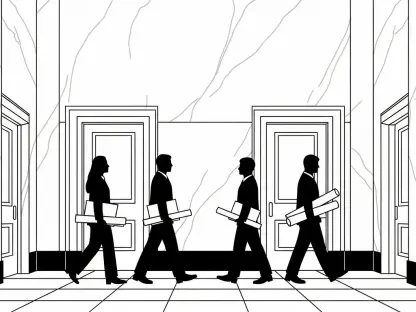Imagine a bustling construction site in the heart of New York City, where a single worker’s injury in 2019 at 1185 Broadway spirals into a multimillion-dollar legal battle over insurance coverage, pitting Zurich Insurance against Lendlease and Starr Indemnity. This conflict raises critical questions about who bears the financial burden when accidents occur. This roundup dives into the ongoing federal court dispute, gathering opinions, tips, and perspectives from industry voices to unpack the complexities of Contractor Controlled Insurance Programs (CCIPs) and their implications for construction projects. The goal is to shed light on differing views, practical takeaways, and the potential ripple effects across the sector.
Unraveling the Legal Battle: Diverse Perspectives on the Dispute
The lawsuit filed by Zurich Insurance against Lendlease and Starr Indemnity stems from a denied coverage claim for subcontractor Global Precast following a 2019 worker injury. Many industry observers note that the heart of this clash lies in the interpretation of CCIP policies, which are meant to centralize insurance for on-site risks. Some legal analysts suggest that Zurich’s push to include Global Precast under the CCIP reflects a broader demand for clarity in how such programs define covered activities, especially in dense urban projects like those in NYC.
Others in the construction management field point out that Lendlease and Starr’s stance—denying coverage based on the claim that Global Precast’s work was off-site—highlights a growing tension in the industry. They argue that the complexity of modern projects, where subcontractors often juggle multiple roles, makes rigid coverage boundaries outdated. This split in opinion sets the stage for a deeper look into how stakeholders view the responsibilities of insurers versus contractors in mitigating financial risks.
A third perspective from insurance brokers emphasizes the unique challenges of claims administration in such disputes. They note that the denial by Lendlease and Starr, facilitated through their claims administrator, has sparked debates over transparency in decision-making. Many believe that this case could push for reforms in how coverage denials are justified, ensuring all parties have access to thorough investigation details before rulings are made.
Core Issues in Zurich’s Coverage Clash: A Spectrum of Opinions
Defining the Boundaries of On-Site Work in CCIP Policies
The central disagreement over what constitutes “on-site” work under CCIP policies has elicited varied reactions from industry professionals. Some insurance consultants argue that Zurich’s assertion—that Global Precast performed active on-site tasks like installation—deserves consideration, as it aligns with the practical realities of subcontractor duties. They contend that a broader interpretation of coverage could prevent similar disputes by acknowledging the interconnected nature of construction tasks.
In contrast, a segment of construction law experts supports the narrower view held by Lendlease and Starr, suggesting that off-site fabrication, as identified in the 2020 investigation report, logically falls outside CCIP scope. They warn that expanding coverage definitions might overburden programs like CCIP, potentially driving up costs for contractors and insurers. This perspective prioritizes strict policy adherence to maintain financial predictability in large-scale projects.
Another angle comes from risk management specialists who critique the investigation process itself. They highlight Zurich’s claim of an incomplete review as a valid concern, arguing that ambiguous or rushed assessments undermine trust in CCIP frameworks. Their view calls for standardized guidelines on evaluating claims to ensure fair outcomes, regardless of where the work physically occurs.
Financial Fallout and Zurich’s Push for Reimbursement
Zurich’s burden of covering defense costs for Global Precast after the coverage denial has sparked discussions about financial equity in insurance disputes. Some financial analysts in the insurance sector sympathize with Zurich’s pursuit of reimbursement, including primary defense obligations and expense repayment. They argue that without judicial intervention, smaller insurers might face unsustainable losses when larger entities deny coverage.
On the other hand, certain construction project managers caution that granting Zurich’s demands could set a precedent that shifts excessive liability onto general contractors like Lendlease. They believe this might discourage firms from adopting CCIPs, fearing unpredictable financial exposure. Their concern centers on balancing the protection of subcontractors with the viability of centralized insurance models.
A different take from legal advisors focuses on the timing and stakes of the upcoming state court trials scheduled for later this year. They suggest that the federal court’s ruling will heavily influence Zurich’s financial risk, potentially creating a domino effect for how costs are allocated in personal injury cases. This opinion underscores the urgency of establishing clear indemnification protocols to avoid prolonged legal and monetary uncertainty.
Evolving Challenges in Construction Insurance Frameworks
The complexities of CCIPs in accommodating subcontractor roles that blur on-site and off-site lines have drawn scrutiny from policy experts. Many note that NYC’s high-density construction environment exacerbates these challenges, as projects often involve intricate supply chains and overlapping responsibilities. They advocate for updated frameworks that reflect these modern dynamics to reduce coverage disputes.
Conversely, some regional contractors argue that while urban settings like NYC amplify issues, the root problem lies in national policy design rather than local conditions. They propose that insurers should prioritize flexible terms over one-size-fits-all rules, allowing for tailored coverage that adapts to project-specific needs. This view seeks to address systemic flaws rather than geographic nuances.
A further perspective from insurance underwriters questions whether current CCIP structures can keep pace with evolving project scopes. They stress the need for proactive dialogue between insurers and contractors to refine claims processes, ensuring that policy language matches real-world applications. Their input highlights a collective push toward modernizing how risks are shared in construction endeavors.
Industry-Wide Ripples from the Zurich-Lendlease Showdown
The potential outcomes of this lawsuit have industry watchers debating its impact on subcontractor protections and CCIP enrollment criteria. Some construction policy analysts predict that a win for Zurich could expand coverage definitions, offering greater security for subcontractors with mixed tasks. They see this as a step toward inclusivity in insurance programs, potentially benefiting smaller firms.
Others, including liability insurance specialists, caution that a victory for Starr and Lendlease might tighten eligibility rules, compelling subcontractors to seek additional private coverage. They argue this could widen the gap between well-resourced and underfunded entities, reshaping competitive dynamics in the sector. Their concern lies in preserving equitable access to project opportunities.
An additional viewpoint from claims transparency advocates focuses on the need for clearer communication in denial justifications. They believe that regardless of the court’s decision, this case exposes a critical flaw in how decisions are relayed to affected parties. Their call for reform aims to ensure that all stakeholders receive detailed reasoning, fostering trust and accountability in insurance dealings.
Key Lessons and Strategic Takeaways: Collective Wisdom
Industry voices agree that the dispute offers valuable lessons on coverage scope disagreements and financial strain, particularly for insurers like Zurich. Many legal consultants recommend that insurers and contractors collaborate on precise policy language to eliminate ambiguity around terms like “on-site” work. This proactive approach could serve as a buffer against future conflicts in complex projects.
Construction risk advisors add that fostering open communication within CCIP agreements is essential to aligning expectations among all parties. They suggest regular policy reviews and joint training sessions to ensure that contractors, subcontractors, and insurers interpret terms consistently. Such steps could minimize misunderstandings that lead to costly litigation.
Subcontractors, according to operational experts, should also take note by securing dual coverage for tasks spanning multiple locations. This strategy acts as a safety net against denials, protecting their financial stability amid coverage disputes. Their advice emphasizes self-reliance as a practical measure while broader industry reforms take shape.
Looking Ahead: Lasting Impact and Next Steps
Reflecting on this legal battle, the discussions among industry stakeholders underscore the significance of Zurich’s fight as a benchmark for navigating insurance intricacies in construction. The diverse opinions gathered reveal a shared concern over policy clarity and financial fairness, shaping how this case is perceived as a turning point. The varied insights provide a comprehensive view of the challenges at hand.
Moving forward, stakeholders should prioritize developing standardized guidelines for CCIP claims evaluations to prevent premature or unclear denials. Insurers and contractors might consider joint task forces to redesign policy frameworks, ensuring they adapt to modern project realities. Additionally, subcontractors could benefit from advocacy groups that push for enhanced protections, offering a collective voice in shaping future insurance norms. These actionable steps pave the way for a more resilient construction insurance landscape.









